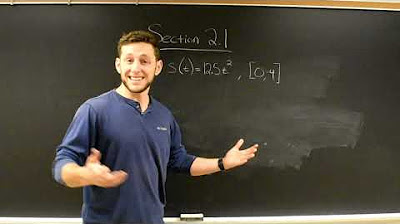Two-Dimensional Motion and Velocity | Physics with Professor Matt Anderson | M4-02
TLDRThe video script delves into the concepts of velocity, focusing on average and instantaneous velocity. It clarifies that average velocity is a vector with the formula delta r over delta t, emphasizing that if the starting and ending points are the same, the average velocity is zero. Instantaneous velocity is explained as the limit of delta r over delta t as time approaches zero, equating it to the derivative in calculus. The script uses a driving example between San Diego and LA to illustrate these concepts and introduces a two-dimensional motion scenario to further the discussion.
Takeaways
- 📌 Average velocity is a vector quantity, often represented with a bar on top instead of an arrow.
- 🚗 The formula for average velocity is the displacement (delta r) divided by the time (delta t).
- 🛣️ An example of average velocity is calculating the velocity for a round trip from San Diego to LA and back to San Diego, which results in zero average velocity.
- 🔄 Zero average velocity over a round trip indicates that the displacement is zero, as the starting and ending points are the same.
- 🏎️ Average speed is different from average velocity; speed does not account for direction, only the total distance covered.
- 🎯 Instantaneous velocity is the velocity at a specific moment in time and is represented without a bar.
- 📐 To calculate instantaneous velocity, take the limit of delta r over delta t as delta t approaches zero.
- 🧮 Instantaneous velocity in calculus is represented by the derivative of the position with respect to time.
- 🌟 The derivative in the context of velocity is a fundamental concept in calculus, relating the rate of change of position to time.
- 📈 For a motion described by r(t) = (1/2)at^2, the instantaneous velocity v(t) is found by differentiating r with respect to t, resulting in v(t) = at i_hat.
- 📊 Two-dimensional motion can be analyzed by applying the principles of velocity and displacement to both horizontal and vertical components.
Q & A
What is average velocity and how is it represented?
-Average velocity is a vector quantity that represents the overall displacement divided by the time taken. It is typically denoted with a bar on top of the symbol to differentiate it from instantaneous velocity, which does not have a bar.
How do you calculate average velocity?
-Average velocity is calculated using the formula v = Δr / Δt, where Δr is the displacement (a vector) and Δt is the time interval (a scalar).
What is the significance of the vector nature of average velocity?
-The vector nature of average velocity means it takes into account both the magnitude and direction of displacement. If the displacement is zero (ending at the starting point), the average velocity is also zero, even if there was movement during the time interval.
What is the difference between average velocity and average speed?
-Average velocity is a vector that considers both speed and direction, while average speed is a scalar that only considers the total distance traveled over time, without regard to direction.
Why would the average velocity for a round trip be zero?
-The average velocity for a round trip would be zero if the starting and ending positions are the same, as the displacement is zero, even though the total distance traveled (average speed) is not zero.
How is instantaneous velocity defined?
-Instantaneous velocity is the velocity of an object at a specific moment in time. It is the limit of the change in position (Δr) divided by the change in time (Δt) as Δt approaches zero.
What is the relationship between instantaneous velocity and derivatives in calculus?
-Instantaneous velocity can be found by taking the derivative of the position function with respect to time. It represents the slope of the position-time graph at any given point, which is the instantaneous rate of change of position.
How do you calculate instantaneous velocity for a given position function?
-To calculate instantaneous velocity from a position function, such as r(t) = (1/2)at^2, you take the derivative of the position with respect to time, which in this case would be v(t) = dr/dt = at.
What is the significance of the hat symbol (i hat) in the context of the script?
-The hat symbol (i hat) is used to denote a unit vector in the direction of the positive i-axis in two-dimensional motion. It is used to indicate the direction of the velocity vector in the context of the example provided.
How does the concept of instantaneous velocity apply to a car's speedometer reading?
-The reading on a car's speedometer at any given moment is an example of instantaneous velocity, as it shows the rate of change of position at that specific time.
What is the difference between one-dimensional and two-dimensional motion when considering velocity?
-In one-dimensional motion, velocity only considers movement along a single axis, whereas in two-dimensional motion, velocity can have components along multiple axes (such as i and j in the x and y directions), and the velocity vector must account for both components.
Outlines
🚗 Understanding Average Velocity
This paragraph introduces the concept of average velocity, emphasizing its vector nature but represented without an arrow for simplicity. It explains average velocity as the ratio of displacement (delta r) to time (delta t), highlighting that displacement is a vector and time is a scalar, resulting in velocity being a vector as well. The content includes a thought-provoking example of driving from San Diego to LA and back, resulting in zero average velocity due to the same starting and ending positions, despite covering a distance. The distinction between velocity (a vector) and speed (a scalar) is clarified, with speed being the rate of motion without direction, calculated as 60 miles per hour in the given example. The paragraph also touches on instantaneous velocity, describing it as the limit of delta r over delta t as t approaches zero, which is analogous to the derivative in calculus.
📐 Instantaneous Velocity and Two-Dimensional Motion
The paragraph delves into the concept of instantaneous velocity, contrasting it with average velocity. Instantaneous velocity is likened to the speed shown on a car's speedometer, representing the limit of the displacement over time as the time interval approaches zero. The explanation includes a practical example of calculating instantaneous velocity from a given function of motion, r(t) = (1/2)at^2, where 'a' is the acceleration and 't' is time. The derivative of this function with respect to time, dr/dt, yields the instantaneous velocity, which is at, emphasizing the need to maintain vector notation when dealing with vector quantities. The paragraph concludes with an introduction to two-dimensional motion, setting the stage for further exploration of motion in more complex scenarios.
Mindmap
Keywords
💡Velocity
💡Displacement
💡Average Velocity
💡Instantaneous Velocity
💡Scalar vs. Vector
💡Derivative
💡Two-Dimensional Motion
💡Calculus
💡Speed
💡Vector Operations
Highlights
Average velocity is a vector quantity, often denoted with a bar on top.
Average velocity is calculated as the displacement (delta r) over time (delta t).
Displacement (delta r) is a vector, while time (delta t) is a scalar.
If you travel from point A to point B and return to point A, your average velocity is zero because the final and initial positions are the same.
Average speed, however, would not be zero for the round trip from San Diego to LA and back, as it is the total distance traveled divided by the time taken.
Instantaneous velocity is the velocity at a specific moment in time and is also a vector.
Instantaneous velocity can be found by taking the limit of delta r over delta t as delta t approaches zero.
In calculus, the limit of delta r over delta t as delta t approaches zero is represented by the derivative.
The derivative in the context of instantaneous velocity is represented as dr/dt.
For the given example of motion in one dimension with r = (1/2)at^2, the instantaneous velocity v is found by differentiating r with respect to time t.
The derivative of (1/2)at^2 with respect to time t is at, resulting in instantaneous velocity v = at i_hat.
When dealing with vectors, it's important to maintain vector notation on both sides of the equation.
The discussion transitions to two-dimensional motion and its analysis.
The concepts of average velocity and instantaneous velocity apply to both one-dimensional and two-dimensional motion.
Understanding the difference between average velocity (which can be zero) and average speed (which accounts for the total distance) is crucial.
The use of calculus, specifically derivatives, is essential in determining instantaneous velocity.
The transcript provides a clear and detailed explanation of velocity concepts, making it accessible for those learning about motion and vectors.
Transcripts
Browse More Related Video

Average/Instantaneous Rates of Changes

What is Velocity? - Full Concept of Velocity - Physics | Infinity Learn

8.01x - Lect 2 - 1D Kinematics - Speed, Velocity, Acceleration

The Velocity Problem | Part II: Graphically

What is Velocity? Physics

Intro to Derivatives, Limits & Tangent Lines in Calculus | Step-by-Step
5.0 / 5 (0 votes)
Thanks for rating: